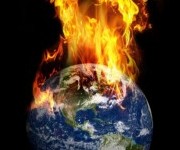To understand our current environmental dilemma, it helps to look at earlier civilizations that also got into environmental trouble. Our early 21st century civilization is not the first to face the prospect of environmentally induced economic decline. The question is how we will respond.
As Jared Diamond points out in his book Collapse, some of the early societies that were in environmental trouble were able to change their ways in time to avoid decline and collapse. Six centuries ago, for example, Icelanders realized that overgrazing on their grass-covered highlands was leading to extensive soil loss from the inherently thin soils of the region. Rather than lose the grasslands and face economic decline, farmers joined together to determine how many sheep the highlands could sustain and then allocated quotas among themselves, thus preserving their grasslands. Their wool production and woolen goods industry continue to thrive today.
Not all societies have fared as well as the Icelanders. The early Sumerian civilization of the fourth millennium BC had advanced far beyond any that had existed before. Its carefully engineered irrigation system gave rise to a highly productive agriculture, one that enabled farmers to produce a food surplus, supporting formation of the first cities and the first written language, cuneiform.
By any measure it was an extraordinary civilization, but there was an environmental flaw in the design of its irrigation system, one that would eventually undermine its food supply. The water that backed up behind dams built across the Euphrates was diverted onto the land through a network of gravity-fed canals. As with most irrigation systems, some irrigation water percolated downward. In this region, where underground drainage was weak, this slowly raised the water table. As the water climbed to within inches of the surface, it began to evaporate into the atmosphere, leaving behind salt. Over time, the accumulation of salt on the soil surface lowered the land’s productivity.
Shifting from wheat to barley, a more salt-tolerant plant, postponed Sumer’s decline, but it was treating the symptoms, not the cause, of their falling crop yields. As salt concentrations continued to build, the yields of barley eventually declined also. The resultant shrinkage of the food supply undermined this once-great civilization. As land productivity declined, so did the civilization.
The New World counterpart to Sumer is the Mayan civilization that developed in the lowlands of what is now Guatemala. It flourished from AD 250 until its collapse around AD 900. Like the Sumerians, the Mayans had developed a sophisticated, highly productive agriculture, this one based on raised plots of earth surrounded by canals that supplied water.
As with Sumer, the Mayan demise was apparently linked to a failing food supply. For this New World civilization, it was deforestation and soil erosion, likely on top of a series of droughts, that undermined agriculture. Food shortages apparently triggered civil conflict among various Mayan cities as they competed for something to eat. Today this region is covered by jungle, reclaimed by nature.
The Icelanders crossed a political tipping point that enabled them to come together and limit grazing before grassland deterioration reached the point of no return. The Sumerians and Mayans failed to do so. Time ran out.
Today, our successes and problems flow from the extraordinary growth in the world economy over the last century. The economy’s annual growth, once measured in billions of dollars, is now measured in the trillions. Indeed, just the annual growth in the output of goods and services in recent years exceeded the total output of the world economy in 1900.
While the economy is growing exponentially, the earth’s natural capacities, such as its ability to supply fresh water, forest products, and seafood, have not increased. Humanity’s collective demands first surpassed the earth’s regenerative capacity around 1980. Today, global demands on natural systems exceed their sustainable yield capacity by nearly 30 percent. We are meeting current demands by consuming the earth’s natural assets, setting the stage for decline and collapse.
In our modern high-tech civilization, it is easy to forget that the economy, indeed our existence, is wholly dependent on the earth’s natural systems and resources. We depend, for example, on the earth’s climate system for an environment hospitable to agriculture, on the hydrological cycle to provide us with fresh water, and on long-term geological processes to convert rocks into the soil that has made the earth such a biologically productive planet.
There are now so many of us placing such heavy demands on the earth that we are overwhelming its natural capacities to meet our needs. Forests are shrinking. Each year overgrazing converts vast areas of grassland into desert. The pumping of underground water exceeds natural recharge in countries containing half the world’s people, leaving many without adequate water.
Each of us depends on the products and services provided by the earth’s ecosystems, ranging from forest to wetlands, from coral reefs to grasslands. Among the services these ecosystems provide are water purification, pollination, carbon sequestration, flood control, and soil conservation. A four-year study of the world’s ecosystems by 1,360 scientists, the Millennium Ecosystem Assessment, reported that 15 of 24 primary ecosystem services are being degraded or pushed beyond their limits. For example, three quarters of oceanic fisheries, a major source of protein in the human diet, are being fished at or beyond their limits, and many are headed toward collapse.
Tropical rainforests are another ecosystem under severe stress, including the vast Amazon rainforest. Thus far roughly 20 percent of the rainforest has been cleared either for cattle ranching or soybean farming. Another 22 percent has been weakened by logging and road building, letting sunlight reach the forest floor, drying it out, and turning it into kindling. When it reaches this point, the rainforest loses its resistance to fire and begins to burn when ignited by lightning strikes. Scientists believe that if half the Amazon is cleared or weakened, this may be the tipping point, the threshold beyond which the rainforest cannot be saved. Daniel Nepstad, an Amazon-based senior scientist from the Woods Hole Research Center, sees a future of “megafires” sweeping through the drying jungle. He notes that the carbon stored in the Amazon’s trees equals roughly 15 years of human-induced carbon emissions in the atmosphere. If we reach this tipping point we will have triggered a major climate feedback, another step that could help seal our fate as a civilization.
The excessive pressures on a given resource typically begin in a few countries and then slowly spread to others. Nigeria and the Philippines, once net exporters of forest products, are now importers. Thailand, now largely deforested, has banned logging. So has China, which is turning to Siberia and to the few remaining forested countries in Southeast Asia, such as Myanmar and Papua New Guinea, for the logs it needs.
As wells go dry, as grasslands are converted into desert, as fisheries are depleted, and as soils erode, people are forced to migrate elsewhere, either within their country or across national boundaries. As the earth’s natural capacities at the local level are exceeded, the declining economic possibilities generate a flow of environmental refugees.
Countries today are facing several negative environmental trends simultaneously, some of which reinforce each other. The earlier civilizations such as the Sumerians and Mayans were often local, rising and falling in isolation from the rest of the world. In contrast, we will either mobilize together to save our global civilization, or we will all be potential victims of its disintegration.
Adapted from Chapter 1, “Entering a New World,” in Lester R. Brown’s Plan B 3.0: Mobilizing to Save Civilization, available for free download and purchase from the Earth Policy Institute.




